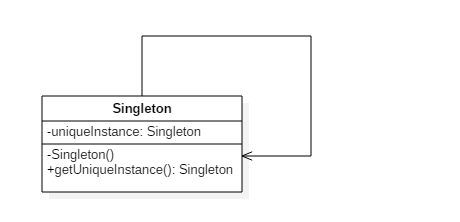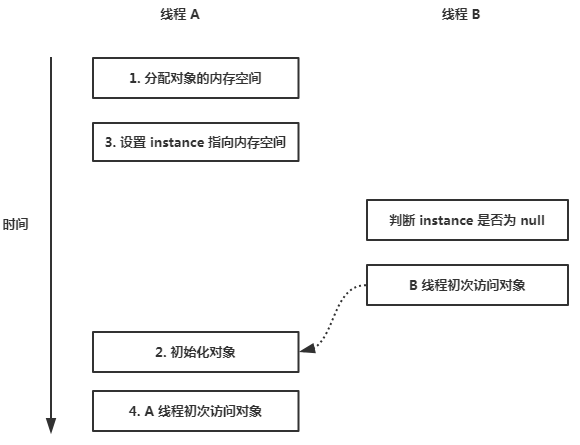单例模式
动机
有时候一个类只有一个实例对象是很重要的。比如,在一个系统中只能有一个 window manager。通常单例模式被用于内部的或者外部的资源的中央管理,它们为自己提供一个全局的访问点。
单例模式是最简单的设计模式之一:它只涉及一个负责实例化自身的类,以确保这个类最多只实例化出一个对象。同时,它提供一个全局访问这个实例的方法。在这种情况下,可以在任何地方使用相同的实例,不可能每次都直接调用构造函数。
意图
- 确保一个类只有一个实例被创建;
- 提供一个访问这个实例的全局点。

实现
1. 懒加载 - 非线程安全
public class UnsafeLazySingleton {
private static UnsafeLazySingleton instance;
private UnsafeLazySingleton() {}
public static UnsafeLazySingleton getInstance() {
if(instance == null) {
instance = new UnsafeLazySingleton();
}
return instance;
}
}
适用场景:没有并发的环境
优点:能够避免内存不必要的浪费
缺点:在并发环境下,会造成一个类创建出多个实例的情况。
2. 懒加载 - 线程安全(synchronized 控制)
public class SafeLazySingleton {
private static SafeLazySingleton instance;
private SafeLazySingleton() {}
public static synchronized SafeLazySingleton getInstance() {
if(instance == null) {
instance = new SafeLazySingleton();
}
return instance;
}
}
显然,通过 synchronized 排斥锁解决了并发环境下可能造成 instance 多次初始化的情况。但是这样做,会导致程序执行性能下降。
为了提高程序的执行性能,我们可以通过双重检查锁定。
public class DoubleCheckSingleton {
private static DoubleCheckSingleton instance;
private DoubleCheckSingleton() {}
public static DoubleCheckSingleton getInstance() {
if(instance != null) {
synchronized(DoubleCheckSingleton.class) {
if(instance != null) {
instance = new DoubleCheckSingleton();
}
}
}
return instance;
}
}
双重检查锁定的实现,提高了程序执行性能,但是它是非线程安全的。为什么这么说呢?
关键是这条语句:instance = new DoubleCheckSingleton();
这行代码可以分解为如下 3 行伪代码:
memory = allocate(); //1. 为新生对象分配内存空间
ctorInstance(memory); //2. 初始化对象
instance = memory; //3. 设置 instance 指向刚分配的内存地址
上面 3 行伪代码中的 2 和 3 之间可能会被重排序。当 2 和 3 发生重排序的时候,伪代码如下:
memory = allocate(); //1. 为新生对象分配内存空间
instance = memory; //3. 设置 instance 指向刚分配的内存地址
ctorInstance(memory); //2. 初始化对象
那么,我们来模拟一下在并发环境下可能出现的情况:

从上图可知,在线程 A 成功获取到 DoubleCheckSingleton 的排斥锁之后,线程 A 开始执行实例过程。线程 A 成功执行完 设置 instance 指向内存空间 这步骤之后,CPU 分配时间给线程 B 去调用 DoubleCheckSingleton.getInstance() 方法。这个时候的 instance 自然不为空,但是却没有初始化。到此为止,已经解释了上面这种双重检查锁定的非线程安全的原因。
知晓问题发生的原因之后,我们可以有 2 个办法来实现双重检查锁定在并发环境下的线程安全。
-
禁止步骤 2 和 3 的重排序。
-
允许 2 和 3 的重排序,但不允许其他线程 “看到” 这个重排序。
2.1 基于 volatile 的解决方案
有兴趣可以看看这篇文章,讲述了 volatile 的内存语义 -> volatile、synchronized 和 final 的内存语义
实现代码如下:
public class DoubleCheckSingleton {
private volatile static DoubleCheckSingleton instance;
private DoubleCheckSingleton() {}
public static DoubleCheckSingleton getInstance() {
if(instance != null) {
synchronized(DoubleCheckSingleton.class) {
if(instance != null) {
instance = new DoubleCheckSingleton();
}
}
}
return instance;
}
}
2.2 基于类初始话的解决方案
JVM 在类的初始化阶段(即在 Class 被加载后,且被线程使用之前),会执行类的初始化。在执行类的初始化期间,JVM 会去获取一个锁。这个锁可以同步多个线程对同一个类的初始化(简单点理解就是避免类被多次初始化)。
基于这个特性,实现代码如下:
public class InstanceFactory {
private static class InstanceHolder {
public static Singleton instance = new Singleton();
}
public static Singleton getInstance() {
return InstanceHolder.instance;
}
}
3. 饿汉模式(线程安全)
public class EarlySingleton {
private static EarlySingleton instance = new EarlySingleton();
private EarlySingleton() {}
public static EarlySingleton getInstance() {
return instance;
}
}
优点:线程安全
缺点:会造成内存的浪费
4. 如何避免反序列化对单例模式的破坏
当一个类实现了序列化的时候,我们来看一下反序列出来的对象是否还是同一个对象。
public class SingletonSerialized implements Serializable {
private static final long serialVersionUID = 1L;
private static SingletonSerialized instance = new SingletonSerialized();
private SingletonSerialized() {
System.out.println("SingletonSerialized is creating");
}
public static SingletonSerialized getInstance() {
return instance;
}
}
测试代码
public class SingletonSerializedTest implements Serializable {
@Test
public void testSingletonSerialized() throws IOException, ClassNotFoundException {
SingletonSerialized serializedObj;
SingletonSerialized instance = SingletonSerialized.getInstance();
FileOutputStream fos = new FileOutputStream("serializedObj.obj");
ObjectOutputStream oos = new ObjectOutputStream(fos);
oos.writeObject(instance);
oos.flush();
oos.close();
FileInputStream fis = new FileInputStream("serializedObj.obj");
ObjectInputStream ois = new ObjectInputStream(fis);
serializedObj = (SingletonSerialized) ois.readObject();
assertEquals(instance, serializedObj);
}
}
结果:测试未通过
那么,有什么方法可以解决反序列化时对象重新创建?
来看下,java.io.Serializable 中的注释,如下:
ANY-ACCESS-MODIFIER Object writeReplace() throws ObjectStreamException;
This writeReplace method is invoked by serialization if the method exists and it would be accessible from a method defined within the class of the object being serialized. Thus, the method can have private, protected and package-private access. Subclass access to this method follows java accessibility rules.
ANY-ACCESS-MODIFIER Object readResolve() throws ObjectStreamException;
This readResolve method follows the same invocation rules and accessibility rules as writeReplace.
从上面的注释可以看出,如果实现了序列化接口的类同时也实现了 writeReplace() 或 readResolve() 这两个方法中的一个,那么在序列化和反序列化的时候就会调用 writeReplace() 和 readResolve() 这两个方法。
了解过 readResolve() 方法之后,我们稍微改一下 SingletonSerialized 类的构造。
public class SingletonSerialized implements Serializable {
private static final long serialVersionUID = 1L;
private static SingletonSerialized instance = new SingletonSerialized();
private SingletonSerialized() {
System.out.println("SingletonSerialized is creating");
}
public static SingletonSerialized getInstance() {
return instance;
}
private Object readResolve() {
return instance;
}
}
最后,重新执行 SingletonSerializedTest 中的测试方法,结果 work as expected。